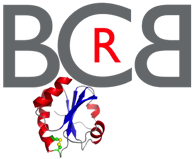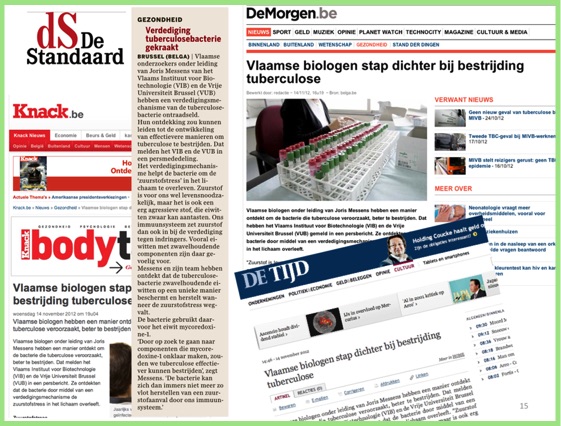Publication in the journal Molecular Microbiology



Press Release
“Missing link” discovered in the defence mechanism of the tuberculosis pathogen
Step towards treating tuberculosis
Brussels, 14 November 2012 – Flemish biologists lead by Joris Messens (VIB / Vrije Universiteit Brussel) have discovered that Mycobacterium tuberculosis – the bacterium that causes tuberculosis – has an ingenious defence mechanism against oxygen. This knowledge is important in the search for a treatment for tuberculosis. 9.4 million people are infected with tuberculosis annually and 1.7 million people die as a result.
Joris Messens: “We have discovered how Mycobacterium survives the oxygen stress in our body, namely with the aid of the protein mycoredoxin-1. This opens up a whole new field of research into the role of this protein during a tuberculosis infection. A better understanding of this mechanism will enable us to combat this bacterium more selectively”.
Oxygen, a necessary evil
Oxygen is essential for the respiration of nearly all cells. They use this gas to burn sugars in order to produce energy. However, oxygen is also very aggressive and can seriously affect proteins – the building blocks of the cell – in a manner similar to rust or oxidation of iron.
Attacking essential proteins
Our immune system uses reactive oxygen molecules in the defence against intruders, for example against Mycobacterium. Proteins are particularly sensitive to the effects of oxygen (oxidation). Proteins with sulphur-containing components are particularly sensitive and become inactive with oxidation. Following damage by oxygen, Mycobacterium places the mycothiol molecule on such proteins. After a period of oxygen stress this molecule has to be removed again for the proper functioning of the protein. It was not known how this happened, until now.
Protection and recovery
Joris Messens and his team have discovered that Mycobacterium tuberculosis protects sulphur-containing proteins in a unique way and actively repairs these proteins once the oxygen stress disappears. They discovered the protein mycoredoxin-1, which forms the basis of this ingenious repair mechanism. The scientists analysed the protein structure and the function of the protein and found that mycoredoxin-1 selectively removes mycothiol from affected sulphur-containing proteins and thereby ensures the activation of these proteins.
Joris Messens: “We could combat tuberculosis more effectively by searching for components that disable mycoredoxin-1. The bacterium would not be able to recover as quickly from an oxygen attack by our immune system.”
Contact:
VIB/VUB
Joris Messens
+ 32 478 91 12 88
Relevant scientific publication
Van Laer, K., Buts, L., Foloppe, N., Vertommen, D., Van Belle, K., Wahni, K., Roos, G., Nilsson, L., Mateos, L. M., Rawat, M., Van Nuland, N. A. and Messens, J. (2012) Mycoredoxin-1 is one of the missing links in the oxidative stress defense mechanism of Mycobacteria. Mol Microbiol 86: 787-804.
Antelmann, H. and Hamilton, C. J. (2012) Bacterial mechanisms of reversible protein S-thiolation: structural and mechanistic insights into mycoredoxins. Mol Microbiol. 86: 759-764
http://onlinelibrary.wiley.com/doi/10.1111/mmi.2012.86.issue-4/issuetoc
Credits When reporting on this research, please mention all partners involved.
VIB
VIB is a non-profit research institute in life sciences. About 1,200 scientists conduct strategic basic research on the molecular mechanisms that are responsible for the functioning of the human body, plants, and microorganisms. Through a close partnership with four Flemish universities − UGent, KU Leuven, University of Antwerp, and Vrije Universiteit Brussel − and a solid funding program, VIB unites the forces of 72 research groups in a single institute. The goal of the research is to extend the boundaries of our knowledge of life. Through its technology transfer activities, VIB translates research results into products for the benefit of consumers and patients and contributes to new economic activity. VIB develops and disseminates a wide range of scientifically substantiated information about all aspects of biotechnology. More information: www.vib.be.
UGent
After more than twenty years of uninterrupted growth, Ghent University is now one of the most important institutions of higher education and research in the Low Countries. Ghent University yearly attracts over 30,000 students, with a foreign student population of over 2,200 EU and non-EU citizens. Ghent University offers a broad range of study programmes in all academic and scientific branches. With a view to cooperation in research and community service, numerous research groups, centres and institutes have been founded over the years. More info: www.UGent.be
Vrije Universiteit Brussel The Vrije Universiteit Brussel (VUB) is a thriving university in the heart of Belgium and Europe, which in 1969-1970 split off from the Université Libre de Bruxelles (ULB), founded in 1834. VUB combines excellence in teaching with excellence in research. Several of its 150 research groups are topranked worldwide. The principle of independent research is central at VUB, but the quality of its undergraduate and graduate programs is no less important, as the university provides an environment where students are treated as individuals and supported in their personal development. Currently, VUB has some 10,000 students and 2,700 staff, divided over eight faculties and two Brussels campuses (in Etterbeek/Elsene and Jette). The VUB University Hospital is adjacent to the Medical Sciences campus in Jette and employs 3,000 people. More info: www.vub.ac.be/.
More info on the Joris Messens lab:.
http://www.vib.be/en/research/scientists/Pages/Joris-Messens-Lab.aspx
http://redox.vub.ac.be/BCRB/home.html
‘Missing link’ ontdekt in verdedigingsmechanisme van de tuberculoseverwekker
Stap richting behandeling tuberculose
Brussel, 14 november 2012 – Vlaamse biologen onder leiding van Joris Messens (Vlaams Instituut voor Biotechnologie/Vrije Universiteit Brussel) hebben ontdekt dat Mycobacterium tuberculosis, de bacterie die tuberculose veroorzaakt, een ingenieus verdedigingsmechanisme tegen zuurstof bezit. Deze kennis is belangrijk in de zoektocht naar een behandeling voor tuberculose. Jaarlijks worden 9,4 miljoen mensen geïnfecteerd en sterven er 1,7 miljoen mensen aan tuberculose.
Joris Messens: “We hebben ontdekt hoe Mycobacterium de zuurstofstress in ons lichaam overleeft, namelijk met behulp van het eiwit mycoredoxine-1. Dit opent een hele nieuw onderzoeksgebied naar de rol van dit eiwit tijdens een tuberculose-infectie. Als we dit mechanisme beter begrijpen zullen we deze bacterie ook selectiever kunnen bestrijden”.
Zuurstof, een noodzakelijk kwaad
Zuurstof is levensnoodzakelijk bij de ademhaling van zowat alle cellen. Die gebruiken het gas onder meer bij het verbranden van suikers om energie te produceren. Maar zuurstof is ook erg agressief en kan eiwitten, de bouwstenen van de cel, zwaar aantasten, een beetje te vergelijken met roesten of oxideren van ijzer.
Levensnoodszakelijke eiwitten aanvallen
Ons immuunsysteem zet de reactieve zuurstofmoleculen in in de verdediging tegen indringers, bijvoorbeeld tegen Mycobacterium. Eiwitten zijn bijzonder gevoelig voor aantasting door zuurstof (oxidatie). Vooral eiwitten met zwavelhoudende componenten zijn hier heel gevoelig voor en verliezen hun werking bij oxidatie. Na beschadeging door zuurstof plaatst Mycobacterium op dergelijke eiwitten het molecule mycothiol geplaatst. Na een periode van zuurstofstress moet dit molecule terug verwijderd worden voor een goede werking van het eiwit. Totnogtoe was niet geweten hoe dit kon.
Beschermen en herstellen
Joris Messens en zijn team hebben ontdekt dat Mycobacterium tuberculosis zwavelhoudende eiwitten op een unieke manier beschermt, en actief herstelt wanneer de zuurstofstress wegvalt. Ze ontdekten het eiwit mycoredoxine-1, dat de basis vormt van dit ingenieuze reparatiemechanisme. De wetenschappers analyseerden de eiwitstructuur en de functie van het eiwit en vonden zo dat mycoredoxine-1 selectief mycothiol verwijdert van aangetaste zwavelhoudende eiwitten en dat het zo zorgt voor de activatie van deze eiwitten. Joris Messens: ”Door op zoek te gaan naar componenten die mycoredoxine-1 onklaar maken, zouden we tuberculose effectiever kunnen bestrijden. De bacterie kan zich dan immers niet meer zo vlot herstellen van een zuurstofaanval door ons immuunsysteem.”
Contact:
VIB/VUB
Joris Messens
+ 32 478 91 12 88
Relevante wetenschappelijke publicatie
Van Laer, K., Buts, L., Foloppe, N., Vertommen, D., Van Belle, K., Wahni, K., Roos, G., Nilsson, L., Mateos, L. M., Rawat, M., Van Nuland, N. A. and Messens, J. (2012) Mycoredoxin-1 is one of the missing links in the oxidative stress defense mechanism of Mycobacteria. Mol Microbiol 86: 787-804.
Antelmann, H. and Hamilton, C. J. (2012) Bacterial mechanisms of reversible protein S-thiolation: structural and mechanistic insights into mycoredoxins. Mol Microbiol. 86: 759-764
http://onlinelibrary.wiley.com/doi/10.1111/mmi.2012.86.issue-4/issuetoc
Financiering
VIB, VUB, IWT, FWO, NIH, LN
Vermelding VIB en universiteit
Wanneer u over dit onderzoek bericht, vragen wij u vriendelijk om steeds zowel VIB als de betrokken universiteit te vernoemen.
VIB
VIB is een non-profit onderzoeksinstituut in de levenswetenschappen. Zo’n 1200 wetenschappers verrichten basisonderzoek naar de moleculaire mechanismen die instaan voor de werking van het menselijk lichaam, planten en micro-organismen. Door een hecht partnerschap met vier Vlaamse universiteiten – UGent, K.U.Leuven, Universiteit Antwerpen en Vrije Universiteit Brussel – en een stevig investeringsprogramma bundelt VIB de krachten van 70 onderzoeksgroepen in één instituut. Hun onderzoek heeft tot doel de grenzen van onze kennis fundamenteel te verleggen. Met zijn technologie-transfer beoogt VIB de omzetting van onderzoeksresultaten in producten ten dienste van de consument en de patiënt. VIB ontwikkelt en verspreidt een breed gamma aan wetenschappelijk onderbouwde informatie over alle aspecten van de biotechnologie. Meer info op www.vib.be.
VUB
De Vrije Universiteit Brussel is een bloeiende universiteit in het hart van België en van Europa, die zich in 1969-1970 afsplitste van de Université Libre de Bruxelles (ULB), opgericht in 1834. De universiteit combineert uitstekend onderwijs met excellent onderzoek. Een aantal van de 150 VUB-onderzoeksgroepen behoort tot de absolute wereldtop. Voor de VUB staat het principe van vrij onderzoek centraal. Maar even belangrijk is de kwaliteit van de bachelor- en masteropleidingen in een omgeving waar studenten geen nummers zijn en waar ruimte is voor individuele begeleiding en zelfontplooiing. Vandaag telt de Vrije Universiteit Brussel ruim 9000 studenten en 2700 personeelsleden, verdeeld over acht faculteiten en twee Brusselse campussen: een in Etterbeek/Elsene en een in Jette. Bij de medische campus in Jette ligt ook het Universitair Ziekenhuis van de Vrije Universiteit Brussel met 3000 personeelsleden.
Het onderzoek gebeurde onder leiding van Joris Messens van het VIB Departement Structurele Biologie, Vrije Universiteit Brussel.
http://www.vib.be/en/research/scientists/Pages/Joris-Messens-Lab.aspx
http://redox.vub.ac.be/BCRB/home.html
Découverte du ‘chaînon manquant’ dans le mécanisme de défense du bacille tuberculeux
Un pas vers le traitement de la tuberculose
Bruxelles, le 14 novembre 2012 – Des biologistes flamands sous la direction de Joris Messens (Vlaams Instituut voor Biotechnologie (l’Institut flamand de biotechnologie)/Vrije Universiteit Brussel) ont découvert que Mycobacterium tuberculosis, la bactérie responsable de la tuberculose possède un ingénieux système de défense contre l’oxygène. Cette connaissance est importante dans la recherche d’un traitement contre la tuberculose. Chaque année, 9,4 millions de personnes sont infectées et 1,7 million de personnes meurent de la tuberculose.
Joris Messens : “Nous avons découvert comment Mycobacterium survit au stress oxydatif dans notre organisme, notamment grâce à la protéine mycorédoxine-1. Ce qui ouvre un tout nouveau domaine de recherche sur le rôle de cette protéine au cours d’une infection tuberculeuse. Si nous comprenons mieux ce mécanisme, nous pourrons combattre cette bactérie de manière plus sélective”.
L’oxygène, un mal nécessaire
L’oxygène est vital pour la respiration de presque la totalité des cellules. Celles-ci utilisent ce gaz entre autres dans la combustion des sucres pour produire de l’énergie. Mais l’oxygène est également très agressif et peut attaquer sévèrement les protéines - les éléments constitutifs de la cellule – de manière à peu près similaire à la rouille ou l’oxydation du fer.
Attaquer les protéines vitales
Notre système immunitaire fait intervenir les molécules réactives à l'oxygène dans la défense contre les intrus, par exemple contre le bacille Mycobacterium. Les protéines sont particulièrement sensibles à l’attaque par l’oxygène (oxydation). Il s’agit surtout des protéines contenant des composés soufrés qui y sont très sensibles et perdent leur activité en cas d’oxydation. Après endommagement par l’oxygène, le germe Mycobacterium fixe la molécule mycothiol sur ces protéines. Après une période de stress oxydatif, cette molécule doit être éliminée pour que la protéine recouvre son bon fonctionnement. Jusqu’ici on ne savait pas de quelle manière.
Protéger et restaurer
Joris Messens et son équipe ont découvert que Mycobacterium tuberculosis protège ses protéines soufrées d’une manière unique et les restaurent activement quand le stress oxydatif disparaît. Ils ont découvert la protéine mycorédoxine-1 qui constitue la base de cet ingénieux mécanisme de réparation. Ces scientifiques ont analysé la structure protéique et la fonction de la protéine et ont trouvé que la mycorédoxine-1 élimine sélectivement le mycothiol des protéines soufrées endommagées et qu’elle assure l’activation de ces protéines. Joris Messens : ”Si on arrive à trouver des composés capables d’inhiber la mycorédoxine-1, nous pourrions lutter efficacement contre la tuberculose. Ainsi, les bactéries ne pourront plus se restaurer rapidement après une attaque de l’oxygène par notre système immunitaire.”
Contact :
VIB/VUB
Joris Messens
+ 32 478 91 12 88
Relevant scientific publication
Van Laer, K., Buts, L., Foloppe, N., Vertommen, D., Van Belle, K., Wahni, K., Roos, G., Nilsson, L., Mateos, L. M., Rawat, M., Van Nuland, N. A. and Messens, J. (2012) Mycoredoxin-1 is one of the missing links in the oxidative stress defense mechanism of Mycobacteria. Mol Microbiol 86: 787-804.
Antelmann, H. and Hamilton, C. J. (2012) Bacterial mechanisms of reversible protein S-thiolation: structural and mechanistic insights into mycoredoxins. Mol Microbiol. 86: 759-764
http://onlinelibrary.wiley.com/doi/10.1111/mmi.2012.86.issue-4/issuetoc
Credits When reporting on this research, please mention all partners involved.
VIB
VIB is a non-profit research institute in life sciences. About 1,200 scientists conduct strategic basic research on the molecular mechanisms that are responsible for the functioning of the human body, plants, and microorganisms. Through a close partnership with four Flemish universities − UGent, KU Leuven, University of Antwerp, and Vrije Universiteit Brussel − and a solid funding program, VIB unites the forces of 72 research groups in a single institute. The goal of the research is to extend the boundaries of our knowledge of life. Through its technology transfer activities, VIB translates research results into products for the benefit of consumers and patients and contributes to new economic activity. VIB develops and disseminates a wide range of scientifically substantiated information about all aspects of biotechnology. More information: www.vib.be.
UGent
After more than twenty years of uninterrupted growth, Ghent University is now one of the most important institutions of higher education and research in the Low Countries. Ghent University yearly attracts over 30,000 students, with a foreign student population of over 2,200 EU and non-EU citizens. Ghent University offers a broad range of study programmes in all academic and scientific branches. With a view to cooperation in research and community service, numerous research groups, centres and institutes have been founded over the years. More info: www.UGent.be
Vrije Universiteit Brussel The Vrije Universiteit Brussel (VUB) is a thriving university in the heart of Belgium and Europe, which in 1969-1970 split off from the Université Libre de Bruxelles (ULB), founded in 1834. VUB combines excellence in teaching with excellence in research. Several of its 150 research groups are topranked worldwide. The principle of independent research is central at VUB, but the quality of its undergraduate and graduate programs is no less important, as the university provides an environment where students are treated as individuals and supported in their personal development. Currently, VUB has some 10,000 students and 2,700 staff, divided over eight faculties and two Brussels campuses (in Etterbeek/Elsene and Jette). The VUB University Hospital is adjacent to the Medical Sciences campus in Jette and employs 3,000 people. More info: www.vub.ac.be/.
More info on the Joris Messens lab:.
http://www.vib.be/en/research/scientists/Pages/Joris-Messens-Lab.aspx
http://redox.vub.ac.be/BCRB/home.html
Persbericht VIB-VUB
Press release VIB-VUB
Communique de presse


